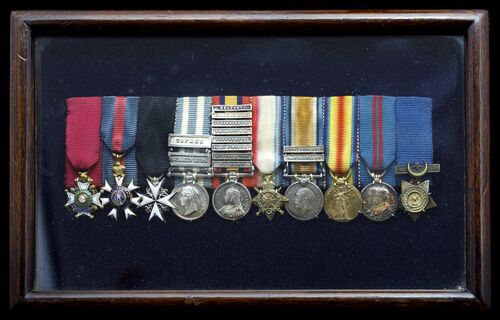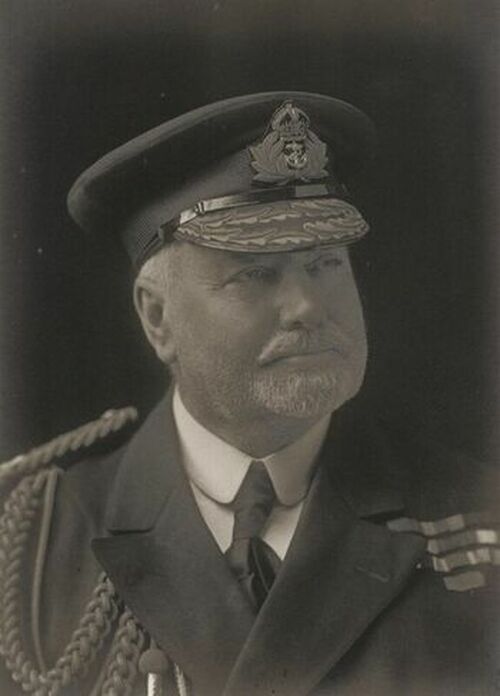Auction: 24002 - Orders, Decorations and Medals
Lot: 301
Sold by Order of a Direct Descendent
The remarkable dress miniature group of ten worn by Vice-Admiral Sir J. Porter, Royal Navy, who left a first-hand account of his near death experience at Tofrek and later served with the Naval Brigade of H.M.S. Doris during the Anglo-Boer War
Medical Director General of the Navy and Honorary Physician to H.M. The King until 1913, he was pulled from retirement to organise the evacuation of the wounded from Gallipoli
The Most Honourable Order of the Bath, Knight Commander's (K.C.B.) Badge, silver-gilt and enamel; The Most Distinguished Order of St. Michael and St. George, Knight Commander's (K.C.M.G.) Badge, silver-gilt and enamel; The Most Venerable Order of St. John, Knight's (K. St. J.) breast Badge, silver and enamel; Egypt and Sudan 1882-1889, dated reverse, 2 clasps, Suakin 1885, Tofrek; South Africa 1899-1902, 8 clasps, Belmont, Modder River, Relief of Kimberly, Paardeburg, Driefontein, Johannesburg, Diamond Hill, Belfast; 1914-15 Star; British War Medal 1914-20, 2 clasps, Dardanelles, Mediterranean; Victory Medal 1914-1919; Delhi Durbar 1911; Khedive's Star 1884-86, mounted in a Spink & Son case, slightly tarnished overall good very fine (10)
K.C.B. London Gazette 24 June 1910.
K.C.M.G. London Gazette 1 January 1916:
'in recognition of services rendered in connection with Naval operations of the war.'
Note only 2 Officer's of the Royal Navy received the Q.S.A. with 8 clasps.
James Porter was born at Monymusk, Aberdeenshire on 5 December 1851, the son of James and Margaret Porter of Village Lane, Monymusk. His father was the local land steward and the young Porter received a good education which allowed him to study medicine at the nearby Aberdeen University. Achieving an M.A. in 1874 he joined a Volunteer unit and served as a Corporal between 1869-77 when he earned his M.D.
Having qualified Porter joined the Royal Navy as a Surgeon on 29 September 1877 at Netley Hospital with his first posting afloat being Rupert in 1878. Further service followed with Duncan, Wye and Orentes, seeing service in the Anglo-Egyptian war with the latter before he was posted to Invincible in 1884 for the Royal Marine Battalion assembling at Suakin. From there they marched to engage a Dervish Force at Hasheen and after defeating them the Battalion joined General McNeill's force at Tofrek where they were to construct a supply post for the advance against Tamaai.
Porter wrote an account of this action for posterity and it is quoted in a compendium written by a relative, his account states:
'About 1.30 p.m. having seen the whereabouts of my men, animals and material of my own department, I divested myself of all encumbrances and walked with Lt. Slessor R.M.A. by gate No. 1. When we had proceeded some 200 yards in the Tamai [SIC] direction, a man rushed past us shouting, "By God, they're on us". Having heard similar cries of wolf before during the previous ten months, we smiled at what we believed to be the same old imaginary swarm of wild arabs. But in less time than I write we were undeceived - a loud roar like the distant sound of the ocean arose seemingly from all round us, and looking some 50 yards ahead the bush was seen to be alive with spearmen, many dressed in multi-coloured calico suits, the Mahdi's uniform, which together with the great agility of their movement presented the appearance of a sudden advance of a multitude of theatrical clowns.
It was then literally a race for life, and fortunately in my case a short one, as a heavy Briton in field boots and helmet would hardly match a light sinewy arab flying along under the burning sun in his native desert. At this critical juncture one portion of the men were cutting wood, the other was in the zereba, which was only partially formed.
As I made for the first knot of grey coats and white helmets (The Royal Marines) I heard hoarse cries of "stand to your arms, men" - "Form rallying square" etc.'
From this hair-raising account we can ascertain that Porter made the cover of a formation of Royal Marines who were stationed in the North-Eastern corner of the zereba. They did find themselves in hand-to-hand combat at one stage of the action but managed to drive the enemy back, Porter would have found himself with a great many casualties to deal with when the dust finally settled.
Returning to service afloat he was to see a great deal more service, being promoted Fleet Surgeon on 3 October 1889 with H.M.S. Scout, a torpedo cruiser at the time commander by Prince Louis Battenberg. Porter was to maintain a friendship with Battenberg for the rest of his life as both men rose to high rank together in the pre-war navy.
Joining H.M.S. Doris prior to the Anglo-Boer War he was posted ashore with her naval Brigade as they supported Lord Methuen's doomed advance to relieve Kimberly. Here he was in on the action at Graspan, Belmont, Modder River and finally the great defeat at Magersfontein. Joining the second attempt Porter was present for the Battle of Paardeburg where the men of Doris' naval Brigade famously captured a Boer gun and mounted it as a memorial to their comrades killed in the fighting.
Porter's service in the war saw him appointed to the special rank of Deputy Inspector-General of Fleets and Hospitals, a role which saw him returned to Britain in 1901. Advanced Director General in 1906 he reached the rank of Director-General of the Medical Department of the Navy on 11 May 1908, becoming Honorary Physician to the King the next year.
Retiring to his home in Kensington in 1913 Porter was not able to enjoy his retirement for long, instead being called back for service in the Great War just a year later. Initially appointed for Special Duty at Pembroke he was given the position of Principal Hospital Transport Officer in the Mediterranean in July the following year. This was an attempt by the British to solve the problems with transporting wounded men from Gallipoli to the hospitals in Malta and Alexandria.
There is some controversy over the effectiveness of this solution with most sources admitting that Porter's stated role overlapped with other senior medical officers causing a considerable amount of confusion. However notably procedures were put in place to inform staff at the hospitals in Egypt and Malta of incoming patients and the Hospital on Lemnos was expanded, both of which eased the strain on the overburdened hospitals.
Retiring again in November 1917 with the rank of Surgeon Vice-Admiral Porter joined the Ministry of National Service which he served in from 1917-1919. He remained on retired pay until his death on 9 August 1935.
Porter was married to Emma Cowan, the daughter of Inspector-General of the Royal Navy M. W. Cowan. He was also a good friend of Rudyard Kipling; sold together with copied research including London Gazette extracts, Scottish Roll of Service extract, British Medical Journal Obituary as well as service records and a copied document recounting his adventures in Sudan.
Subject to 20% VAT on Buyer’s Premium. For more information please view Terms and Conditions for Buyers.
Sold for
£1,100
Starting price
£600







